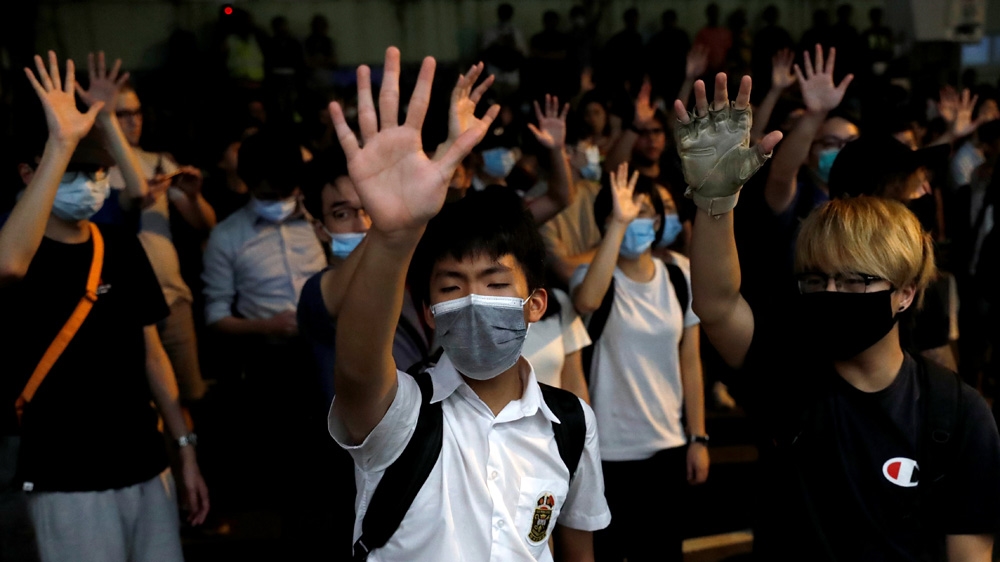Carrie Lam launches listening tour with Hong Kong protesters
After months of demonstrations, Lam spoke face-to-face with 150 citizens drawn from 20,000 who entered for the chance.

Hong Kong, China – Calling it “one step forward” on the “long road to reconciliation,” Chief Executive Carrie Lam kicked off her listening tour on Thursday and finally faced the public.
For more than four months, the semi-autonomous Chinese city has been engulfed by anti-government protests that counted nearly two million participants at their peak.
Keep reading
list of 4 itemsThe Take: Where are Hong Kong’s protesters now?
Hong Kong’s new security law comes into force amid human rights concerns
Hong Kong passes tough new national security law
But on Thursday night, only 150 citizens – out of 20,000 who entered a draw – spoke face-to-face with their beleaguered leader inside a neighbourhood stadium.
“Even though I reckon the public’s trust in us is at a record low, my government is trying to find a way out of the morass,” said Lam. “And the buck stops with me.”
Flanked by three of her ministers, Lam listened grim-faced as about two dozen among the audience were randomly selected to ask questions. Most spoke in a calm and measured tone, though a few made impassioned speeches about despair over their city in protracted political turmoil.
Their most consistent demand was for an independent inquiry into alleged police brutality in suppressing the protests.
Although Lam struck a conciliatory note throughout, she stopped short of making any commitment to address the demand.
Tempers flared towards the end of the two-hour session with some in the audience heckling her about sidestepping their questions.
“I had no expectation so there was no disappointment,” said Nelson Chan, 39, an electrical engineer, as he left the dialogue session. “I came here thinking that there was a slim chance of changing the situation by getting involved.”
Attempt to calm unrest
With protesters planning to ratchet up their action before the October 1 celebrations over the 70th anniversary of the founding of the People’s Republic of China, Lam’s imperative is to show she can calm the unrest without intervention from Beijing.
Veteran commentator on Chinese politics Ching Cheong said this was unlikely.
“This did little to dial down public anger especially when the overwhelming demand wasn’t being met,” said Ching. “This was but a PR show for Beijing and the world to see she was doing something.”
The former British colony reverted to Chinese sovereignty in 1997 under the “one country, two systems” framework, which guarantees Hong Kong people rights and freedoms largely absent in mainland China.
However, in recent years – as Beijing has increasingly interfered in the territory and postponed free-and-fair elections – resentment has boiled over.

The last straw came this spring when the government pushed forward with legislation that would allow anyone in the city to be sent for trial in China, where courts are notoriously opaque and the right to a fair trial cannot be ensured.
Even after the legislation was withdrawn, the demonstrations have morphed into a wider, largely leaderless movement demanding a blanket amnesty for all those charged with offences stemming from their involvement in demonstrations, and a refutation of the police claim that protesters were guilty of rioting – a charge that carries a heavy prison sentence.
Free-and-fair elections
Protesters are also pressing for full democracy.
Throughout the evening, a few thousand demonstrators congregated outside to shout their demands: “I want free-and-fair elections.”
Even after the dialogue event ended they refused to leave, hoping to meet Lam’s convoy and asking her to face more of her people. As they stood their ground, they faced off with a formation of riot police officers on the other side of the stadium’s glass door.
A career civil servant for nearly four decades, Lam was elected in 2017 by an electorate of 1,200 mostly Beijing loyalists out of the city’s 3.8 million registered voters at the time.
In 2014, as chief secretary – Hong Kong government’s number two official – Lam led the dialogue with student leaders during the first month of the pro-democracy Umbrella Movement.
The talk yielded no progress and the sit-in lasted another six weeks before it was ultimately dispersed under court orders.